What is Paschimottanasana (Seated Forward Bend)?
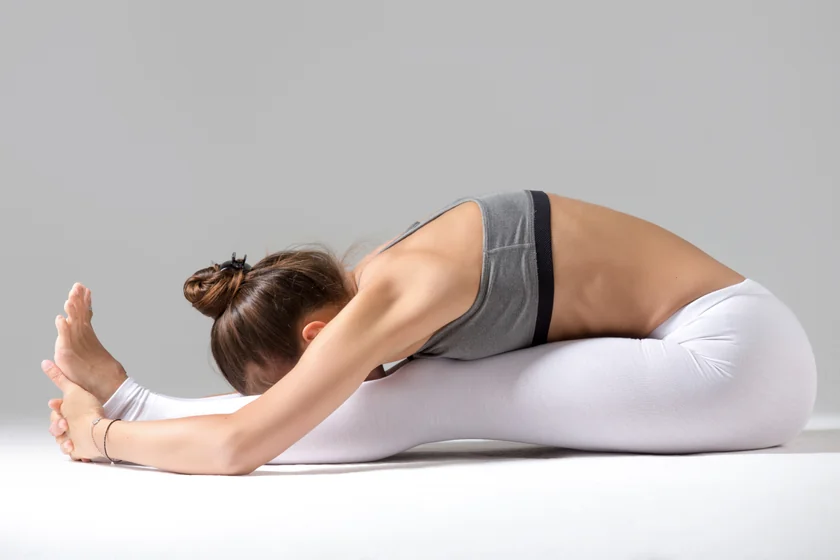
The Paschimottanasana, or Seated Forward Bend, is an easy-looking yoga asana that practitioners often overlook, especially beginners who are not familiar with the benefits of this pose, or who ignore this practice due to its low level of challenge.
Extending the top half of your body and lowering yourself to the floor stretches the entire back, neck, shoulders, and arms. As a result, it improves physical flexibility and stimulates relaxation in the lower back and hamstring muscles.
That’s why a seated forward fold pose is always a must-do in your yoga routine, especially after deep backbend practice. Now, let’s learn more about this calming pose.
Overview & Etymology
In Sanskrit, Paschim means "West" or "The Back of Body"; Uttana means "Intense Stretch" or "Straight" or "Extended"; and Asana means "Posture" or "Seat."
The pose is mentioned in the Hatha Yoga Pradipika, chapter 1, verses 28-29, from the 15th century. It states that Paschimottanasana is among the best asanas for boosting the energy currents in the whole body.
Also, HYP states that in the seated forward fold, the spinal column is stretched and the entire nervous system is stimulated, increasing Prana Vayu flow (inward flow of energy) and Apana Vayu flow (outwards flow of energy), respectively - this helps in bringing the body and mind into a state of balance.
Sanskrit Name: पश्चिमोत्तानासन Pronunciation: PASH-chee-moh-tan-AHS-anna
Pose Type: Seated, Forward Bending Also known as: Seated Forward Bend
Strengthens: Lower Back and Hamstrings Stretches: Spine, Shoulders, and Hamstrings
Health Benefits of Paschimottanasana
Reduces stiffness from the legs.
Lengthens and strengthens the back.
Aids digestion and boosts metabolism.
Improves blood circulation around the pelvic region.
Enhances the nervous system and rejuvenates the mind.
Stimulates abdominal organs, like - kidneys, intestines, liver, and pancreas.
When to Avoid Performing Paschimottanasana
Avoid during pregnancy.
Avoid if you have a hernia.
Avoid if you have spondylitis.
Avoid if you have a slipped disc.
Avoid if you have a recent injury or surgery.
How to do Paschimottanasana (Seated Forward Bend)
With the help of certified instructors, we’ve divided our detailed guide for this asana into four different parts below. These four parts describe warm-up poses, relaxation poses, tips, and a step-by-step guide to practice and execute Paschimottanasana.
Part 1 - Preparatory Poses for Paschimottanasana
Start with a few simple ankle rotations and back stretches to activate the blood flow in those areas, especially if you’re performing this pose after waking up early in the morning.
Keeping the back and spine straight in Paschimottanasana might be difficult for new yogis. The following are some of the preparatory positions that you can use to warm up your leg and back muscles before the main pose:
1. Baddha Konasana (Bound Angle Pose) - In this seated warm-up pose, the inner thighs and lower back are activated right away. Start with sitting in the staff pose and then gently bend your legs from your knees and place them in Namaste Feet formation by touching the bases of your feet together.
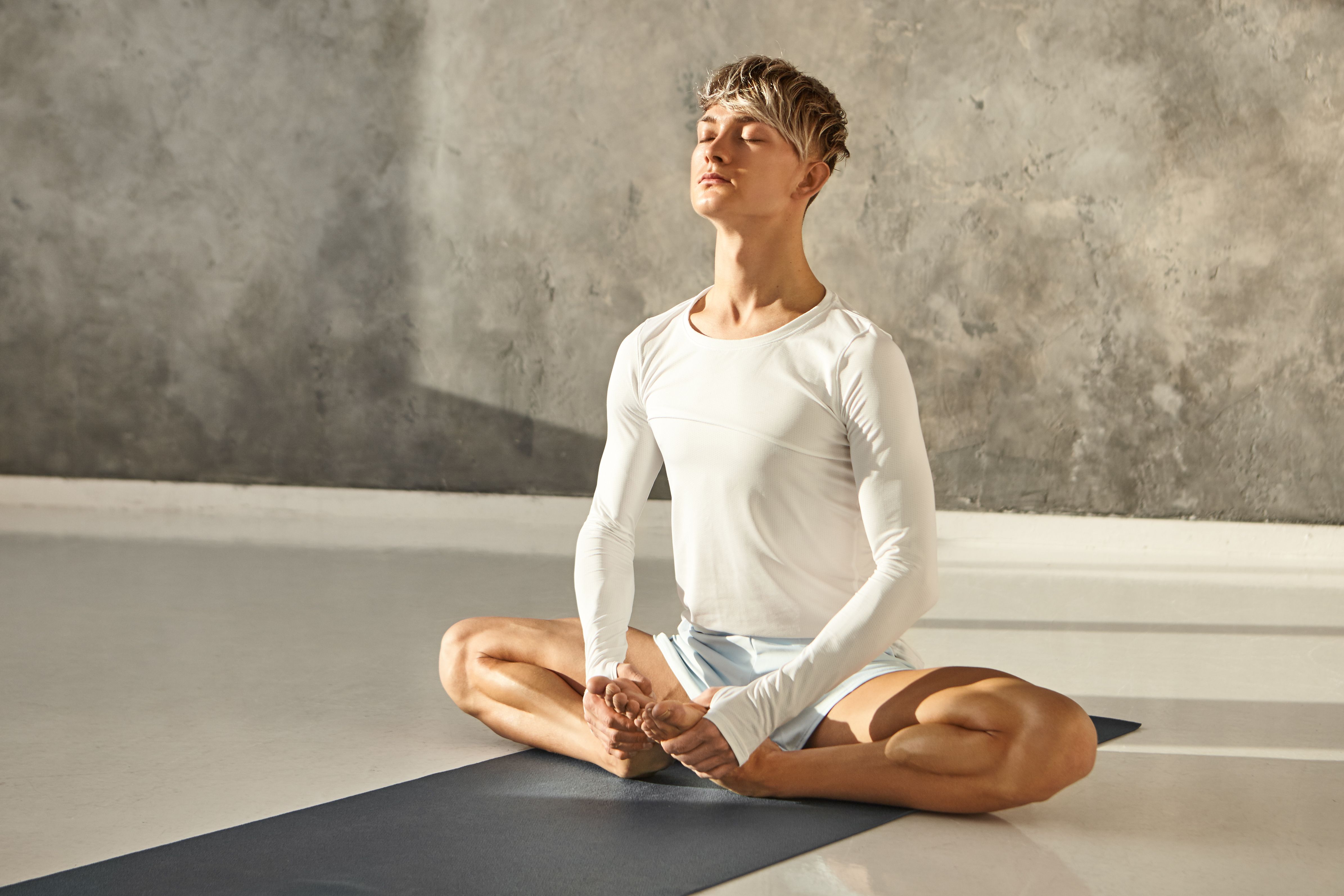
Make sure your knees touch the yoga mat and hold this pose for five minutes to attain a deeper opening in the glutes and thighs. For stability in the feet placement, hold both your feet between your palms.
2. Baddha Konasana Uttanasana (Bound Angle Forward Bend Pose) - Arch the lower back and bend your head down over the Namaste Legs formation.

This will help you stretch and open the back muscles by triggering more blood flow in that region. Hold this pose for three to five more minutes.
3. Balasana (Child Pose) - Get seated onto your shins and place your hands behind you by reaching for your heels; you'll feel a slight stretch in your spine, shoulders, and neck. Plus, this pose helps to activate your abdominal muscles.

Make sure to bring your upper body closer to the ground and hold this pose for three to five minutes. Once you feel the release of tension, your body will be completely activated and ready for the main practice.
Part 2: Step-by-Step Instructions to Perform Paschimottanasana
Following are steps to practice the Seated Forward Bend:
Step 1- Sit in the center on the mat and get into Dandasana (Staff Pose).
Step 2- By stretching both legs out in front of you, stay seated in this posture with your spine raised to the sky. Make sure the back of your knees are touching the yoga mat.
Step 3- With your arms stretching out, take a deep breath and raise them entirely over your head as you fill up your lungs.
Step 4- Now, slowly lean forward with your stretched-out arms and place your head and chest onto your legs with a deep exhale.
Step 5- Both your arms should flex forward and hold your big toe. Engage and tuck your abdomen in as you bring your chin and chest close to your knees.
Step 6- To relax your lower back and re-vitalize the spine, focusing on breathing with your head down.
Breath Awareness: Make sure to inhale deeply when seated in the staff pose and exhale twice the size you inhale while bending forward. Also, follow a steady pace of breathing continuously, while holding the pose for longer durations.
Performance Duration for Beginners: Hold the Paschimottanasana for 1 minute.
Performance Duration for Advanced: Hold for as long as you feel comfortable.
Part 3: Things to Keep in Mind
Proper alignment is crucial when practicing Seated Forward Bend. Here are a few cues for beginners to keep in mind for a safe practice of Paschimottanasana:
Try not to overstretch: Overstretching can occur while pushing the body way further than it needs to. Make sure your buttocks are glued to the mat, not rising. If the butt is lifted, you are putting too much strain on your shoulders and neck.
Keep the back straight: The urge to get your head down onto your shins can make you round your back while forward bending. So, make sure you lean forward, vertebrate-by-vertebrate, and keep your back straight. You need a straight back to breathe smoothly without any obstruction.
Do not lock the knees: In order to feel a muscle stretch in the hamstrings, it’s common for yogis to lock up the knees and make the back of the knees touch the mat. This is the wrong way of doing it, as this can strain the knee joints, leading to pain. To avoid this, make sure you engage your thighs and quads with a slight bend in the knees to stop them from locking up.
Part 4: Relaxing Poses After Paschimottanasana
The Seated Forward Bend is itself known as a relaxing counterpose for backbends in yoga. But, to relax after this pose, we have listed three yoga asanas below that will provide deep relaxation to your body after an elongated Paschimottanasana practice.
1. Dandasana (Staff Pose): Sit back up from the seated forward fold into the staff pose. Inhale deeply and erect your spine towards the sky.

Place your hands on the sides of your glutes on the ground and hold this pose for two to three minutes here. Ensure your neck's alignment is neutral while gazing in front of you.
2. Setu Bandha Sarvangasana (Bridge Pose): Lay down in the Corpse Pose and take a few deep breaths here. Place your hands on the side of your mat. Now, press with the help of your hands and feet to lift the core upwards.
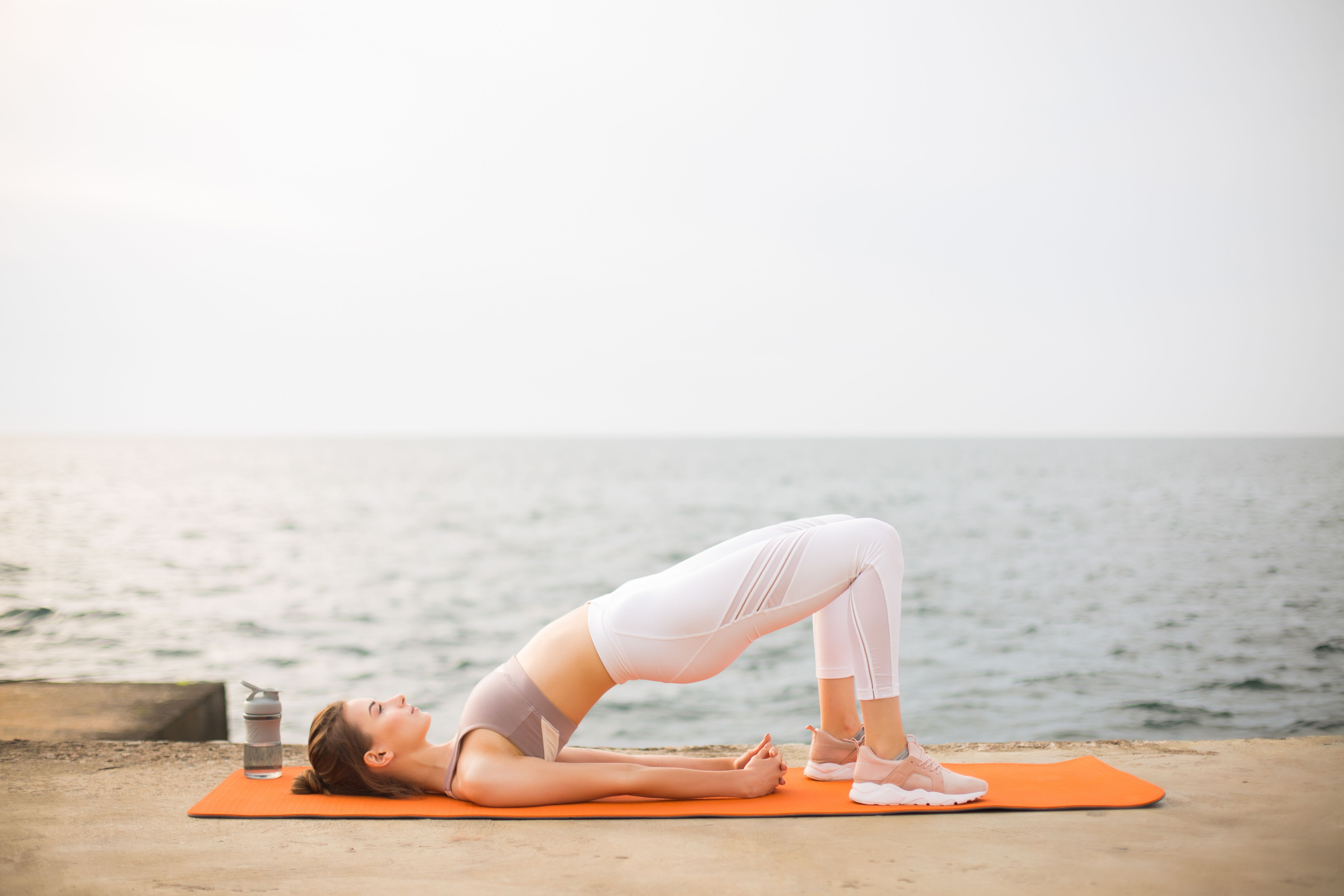
This pose works as a counteraction for the Paschimottanasana, as the core is flexing up towards the sky; it assists the lower back and hamstrings in getting back into normal alignment.
3. Purvottanasana (Upward Plank Pose): This is also known as the reverse plank position. It is commonly practiced after Paschimottanasana, releasing any tension left behind around the lower back and spine.
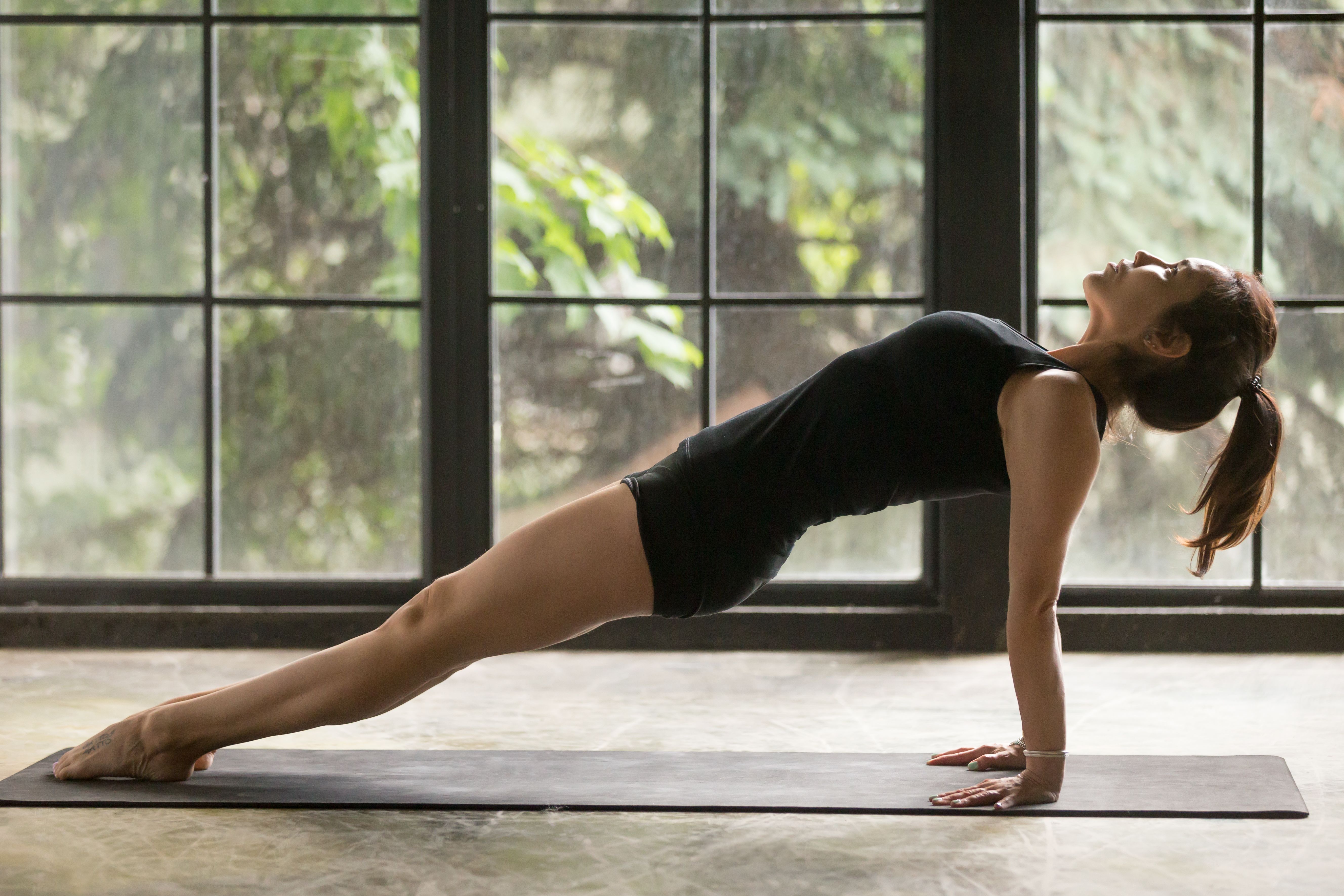
So, first, lift your body on all fours in the reverse tabletop position and then straighten up both your legs to execute Purvottanasana. Hold this posture for only 60 to 90 seconds, and then lie down back in Savasana.
Paschimottanasana Variations to Consider
Based on your body’s flexibility and mobility, you can try multiple variations of Paschimottanasana. Here are a few listed below:
1. Paschimottanasana A: If you want to go a little deeper in your Paschimottanasana practice, try this variation of holding onto your toes with your hands and keeping your forehead down in a relaxed mode.
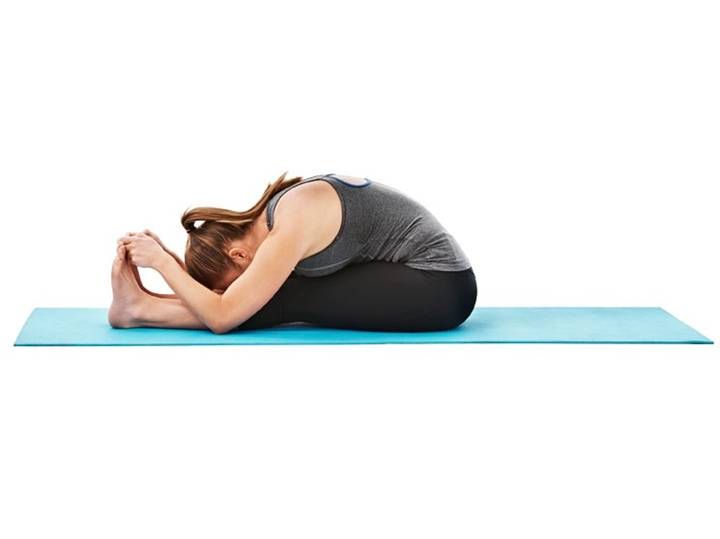
Feel an immense deep stretch in your tailbone, back, and shoulders. You can hold it here for 5 to 10 deep breaths.
2. One Leg Seated Forward Bend:
This is also known as Trianga Mukhaikapada Paschimottanasana, a very popular variation of the Seated Forward Bend from Ashtanga Yoga.
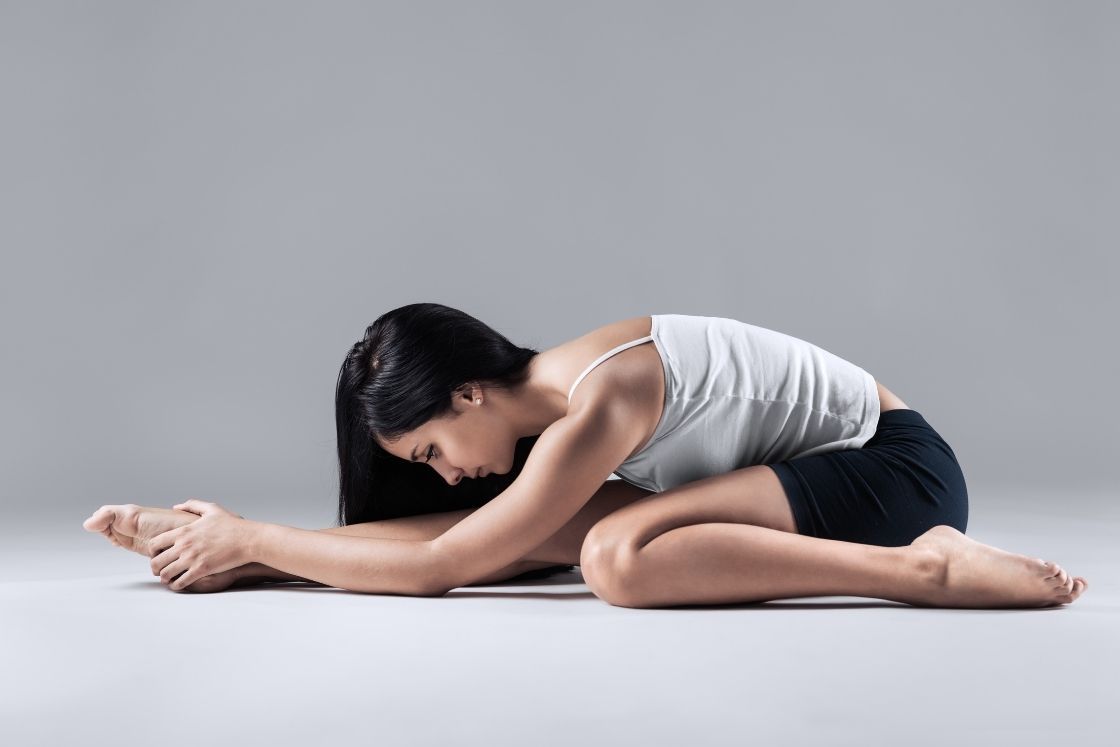
Continue from Paschimottanasana, bend one leg, keep it on the side of one glute, with the other leg stretched out straight in front. This variation helps to build strength around the hamstrings, glutes, and lower back.
3. Deeper Forward Fold With Blocks: If you feel everything we have listed so far is too easy for you, then try adding one or two yoga blocks in front of your feet.

The added yoga blocks will increase resistance while you stretch down with the middle body, head, and arms stretched in the front straight.

Enjoy a Free 1-on-1 Session with a Coach!
Receive personalized guidance tailored to your unique fitness goals, live with a dedicated coach—no credit card required.
Frequently Asked Questions about Paschimottanasana
Paschimottanasana is a seated yoga asana, and it is a foundational pose for many beginner yogis. This seated forward bending stretch aids in enhanced blood circulation around the lower back, shoulders, spine, abdomen, and pelvis, improving the organ function around these muscle areas.
The following are steps to perform Paschimottanasana Pose:
1. Start by sitting in the staff pose.
2. Inhale deep and bring your arms over your head.
3. Fill your lungs with air and close both eyes.
4. Now, vertebrate by vertebrate, lean down forward onto your legs.
5. Exhale deeply as you lower down until your head is resting on your knees.
6. Keep your arms stretched forward and hold this pose until your body is completely relaxed.
Ardha Baddha Padma Paschimottanasana or Half Bound Lotus Forward Fold is a level-up variation for straight leg forward bend. This variation of the Paschimottanasana intensifies the pressure around the abdominal organs and improves digestive function even further.
Yes, beginners can regularly perform Seated Forward Bend Pose as their warm-up and relaxation routine, and increase flexibility in their lower back and hamstrings over time.
Diseases like diabetes, PCOD, PCOS, erectile dysfunction, high blood pressure, and depression can be cured via the regular practice of Paschimottanasana.



.webp)
%20(7).jpg)




